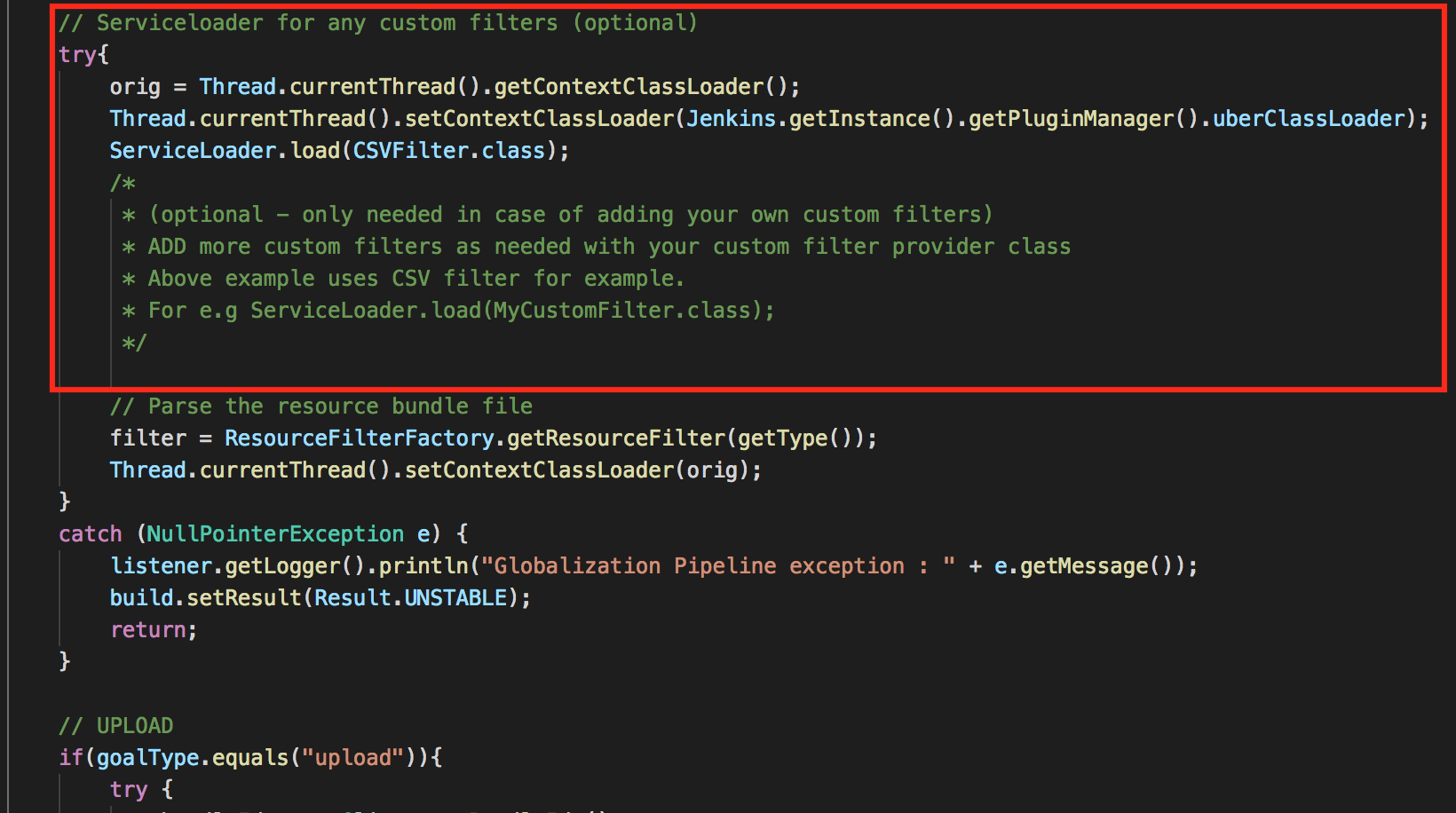Globalization Pipeline Jenkins Plugin User Guide
- Overview
- Prerequisites
- Installation
- Operations
- Usage
- Configuration Parameter Reference
- Custom Resource Filter
Overview
Globalizaton Pipeline Jenkins Plugin is designed for integrating Globalization Pipeline service with Jenkins jobs and builds. The plugin can upload translatable resource bundles from any Jenkins job workspace to an instance of Globalization Pipeline service and download translated resource bundles to Jenkins job workspace.
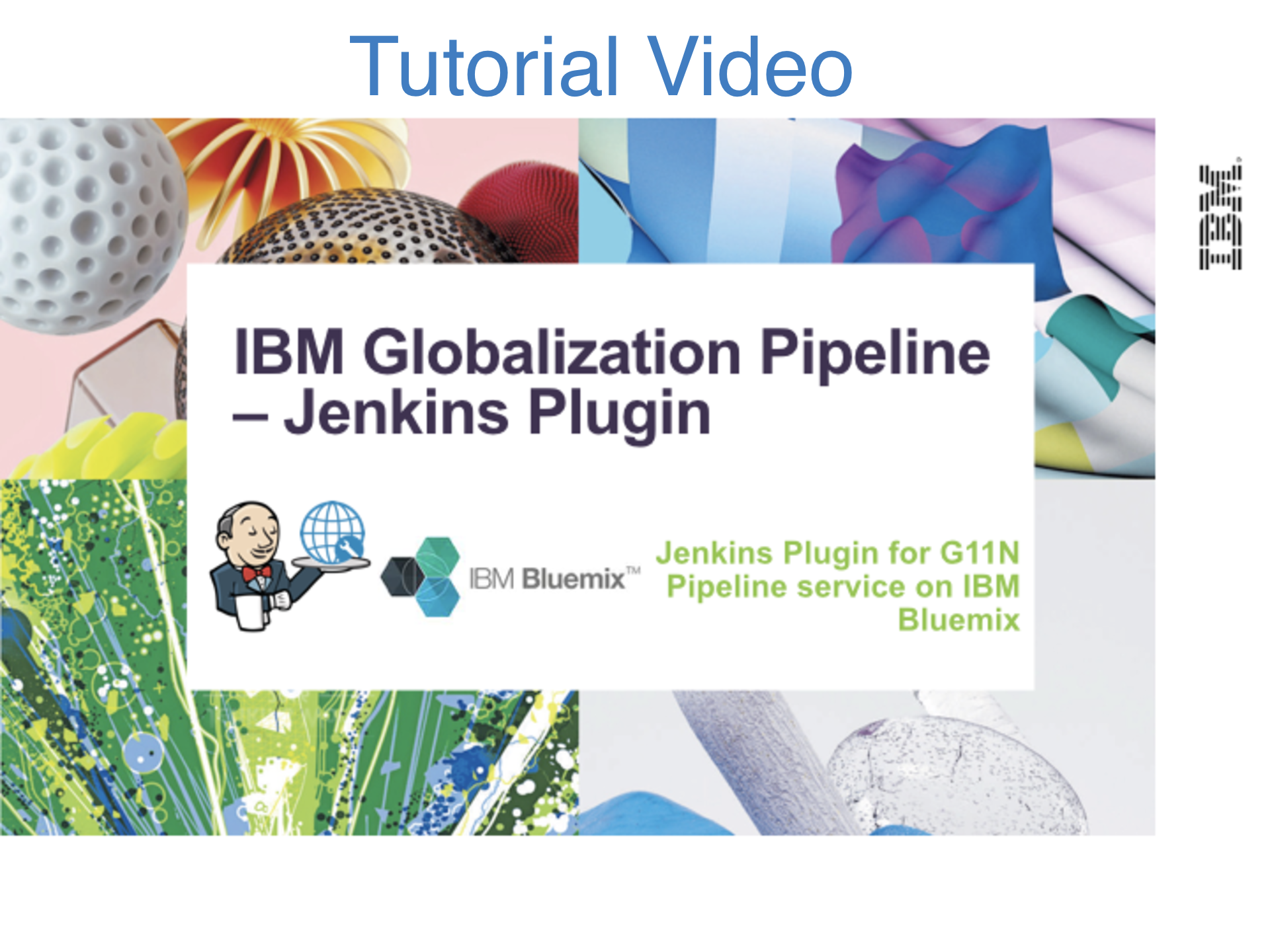
Prerequisites
- Jenkins with v1.625.3 or greater
- IBM Globalization Pipeline instance on any region of IBM Cloud.
- Maven v3.0 or greater
Installation
Add following settings.xml file in ${user.home}/.m2 folder
<settings>
<pluginGroups>
<pluginGroup>org.jenkins-ci.tools</pluginGroup>
</pluginGroups>
<profiles>
<!-- Give access to Jenkins plugins -->
<profile>
<id>jenkins</id>
<activation>
<activeByDefault>true</activeByDefault> <!-- change this to false, if you don't like to have it on per default -->
</activation>
<repositories>
<repository>
<id>repo.jenkins-ci.org</id>
<url>https://repo.jenkins-ci.org/public/</url>
</repository>
</repositories>
<pluginRepositories>
<pluginRepository>
<id>repo.jenkins-ci.org</id>
<url>https://repo.jenkins-ci.org/public/</url>
</pluginRepository>
</pluginRepositories>
</profile>
</profiles>
<mirrors>
<mirror>
<id>repo.jenkins-ci.org</id>
<url>https://repo.jenkins-ci.org/public/</url>
<mirrorOf>m.g.o-public</mirrorOf>
</mirror>
</mirrors>
</settings>
This file is shown in Setting up Environment section. Please double check the file content from there.
Now, clone ibm-g11n-pipeline-plugin repository and run mvn clean install in this repository.
This will create ibm-g11n-pipeline.hpi file in target folder.
Now, share this ibm-g11n-pipeline.hpi to your Jenkins admin or if your are hosting Jenkins as an admin, please upload ibm-g11n-pipeline.hpi plugin.
If you want to run this plugin without uploading to your Jenkins space, you can test this plugin in a stand-alone Jenkins instance by running mvn hpi:run on cloned repository folder.
Once you have this plugin installed in your Jenkins space, you add a Build Step called IBM Globalization Pipeline in your existing or newly created Jenkins job.
Operations
In this Build Step, Operations available for this plugin are below.

| Operation | Description |
|---|---|
| upload | Upload translatable resource bundle files from Jenkins job workspace to an instance of Globalization Pipeline service. |
| download | Download translated resource bundles from an instance of Globalization Pipeline service to Jenkins job workspace. |
Usage
Specifying Globalization Pipeline Service Credentials
The plugin requires service instance administrator credentials for a Globalization Pipeline service instance. Please refer Quick Start Guide to see how to get service credentials information of your Globalization Pipeline instance.
Fill those credentials in this Build Step and test connection.

Basic Use Case
By default, Globalization Pipeline plugin assumes all translatable English resource bundle files are in Java property resource bundle format (*.properties) and they are placed under the standard directory (src/main/resources) in your Jenkins job workspace. If your project follow this convention, you don’t need to override default configuration in Build Step.
Uploading Source Resource Bundles
Operation : upload
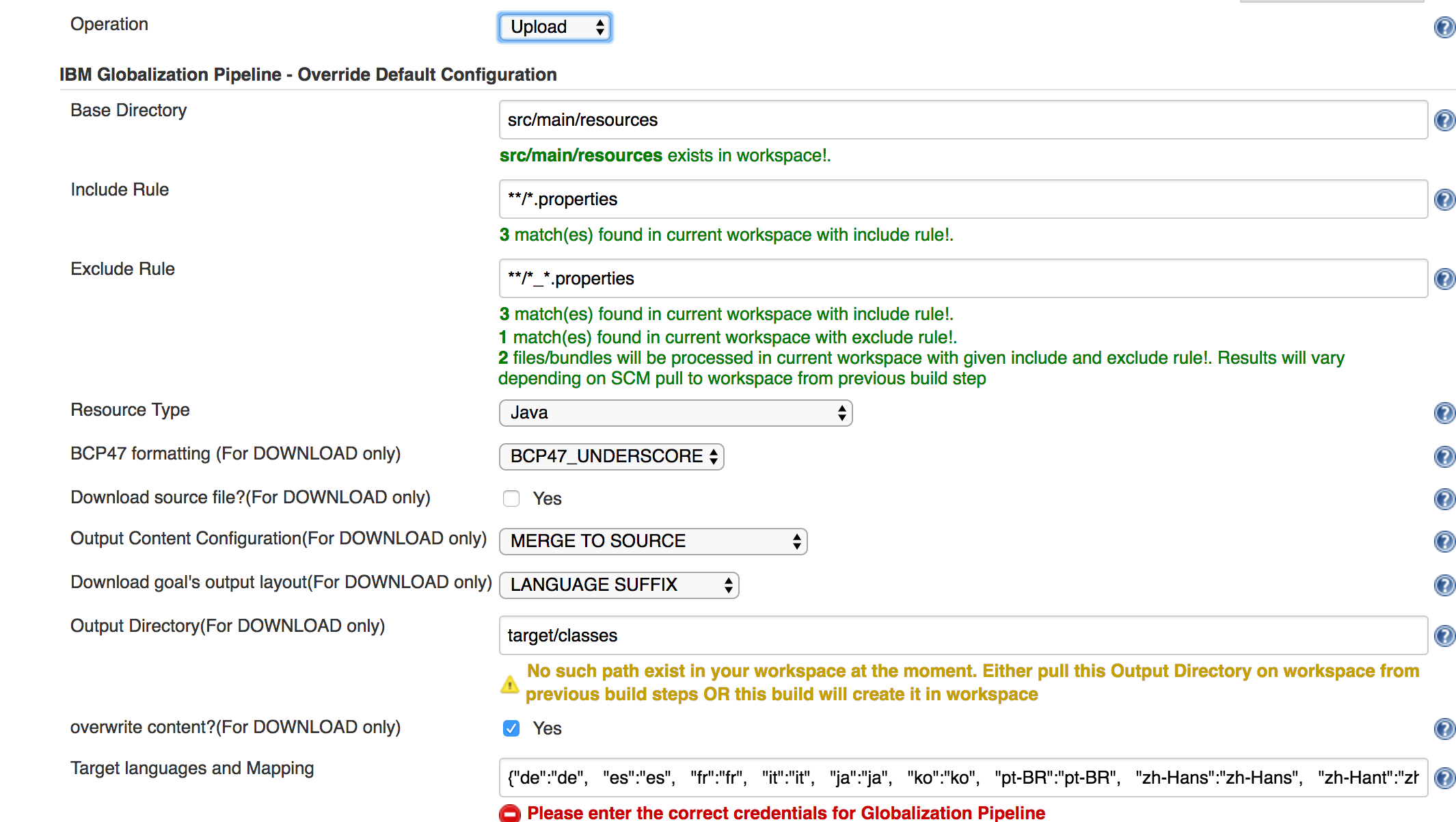
This goal does following tasks:
-
Scans files under
src/main/resourcesfor Jenkins job workspace and locates files with.propertiesextension (but excluding files with ‘_‘(underscore) character in its file name, such asMessages_fr.properties). -
For each Java property resource bundle file, checks if corresponding Globalization Pipeline bundle already exists or not. If it’s not available, creates a new bundle with all translation target languages currently configured. English is used as the translation source language.
-
Extracts resource strings from each file, and uploads them to the matching Globalization Pipeline bundle as the translation source.
This operation will synchronize the contents of a Globalization Pipeline bundle with the contents of files in Jenkins job workspace. When a resource key was deleted from those files, it will be also deleted from the corresponding Globalization Pipeline bundle. If a resource string value was changed, this operation refreshes the corresponding resource string’s value, which eventually triggers re-translation. When the contents is not changed since last invocation, this operation does not make any changes in the Globalization Pipeline bundles.
So the best practice would be invoking this goal when any changes were made in translatable resource bundle files, although it’s not harmful to invoke the goal at any time.
Downloading Translated Resource Bundles
Operation : Download
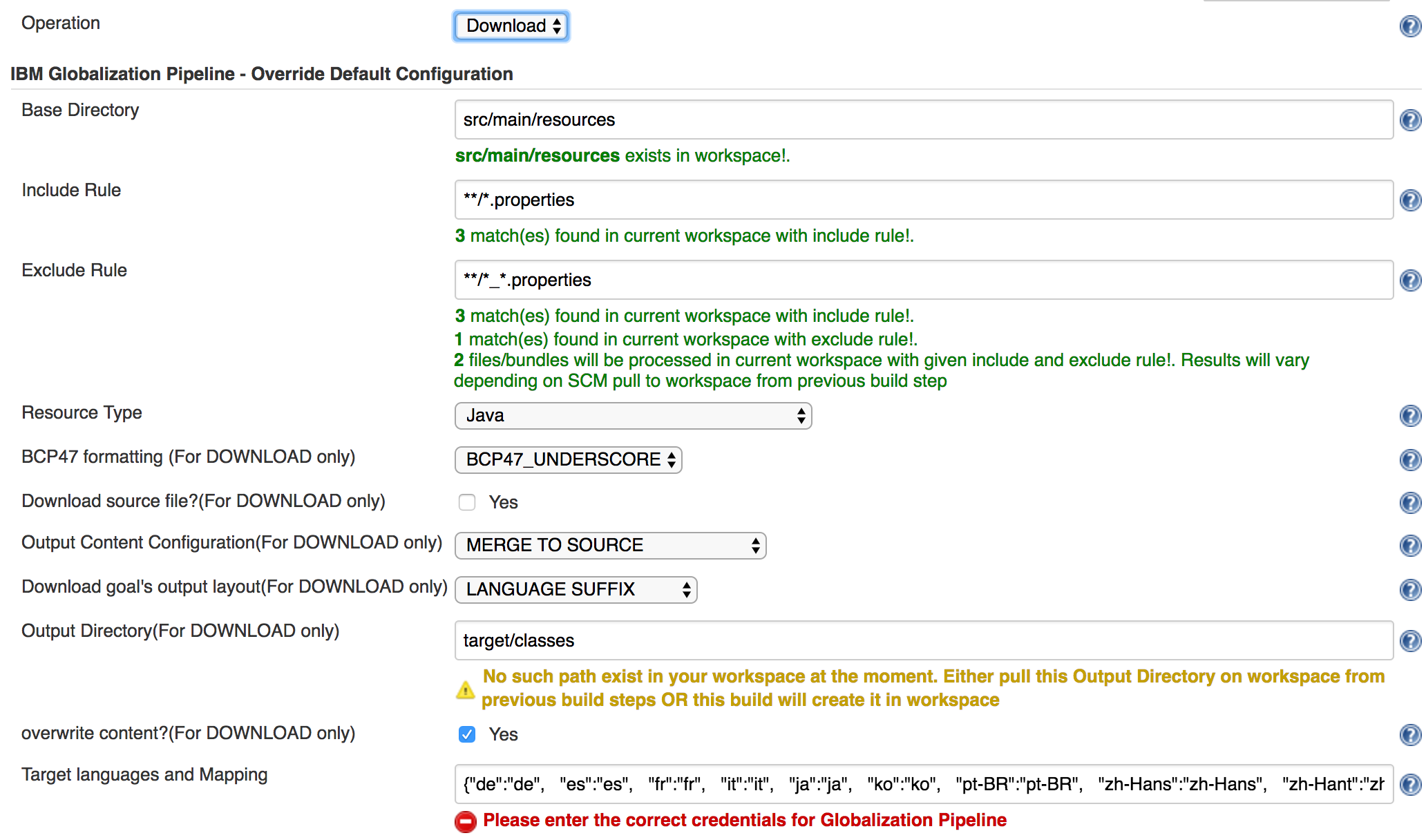
This goal does following tasks:
-
Scans files under
src/main/resourcesin Jenkins job workspace and locates Java property resource bundle files. This is same as in the upload operation. -
For each Java property resource bundle file, check if look up corresponding Globalization Pipeline bundle in the instance of Globalization Pipeline service.
-
If matching Globalization Pipeline bundle is found, copies the contents of source bundle file in Jenkins job workspace, extracts resource strings from the Globalization Pipeline bundle, then replaces resource string values with ones extracted from the Globalization Pipeline bundle. The result file is generated under the standard build output directory (
target/classes) in Jenkins job workspace with language suffix, such asMessages_fr.propertiesfor French. This operation is done for all available target languages in the Globalization Pipeline bundle.
In many cases, you will likely want to execute the goal during package phase
and include translated resource bundles downloaded from an instance of Globalization
Pipeline service.
Advanced Use Cases
Globalization Pipeline Jenkins Plugin supports various configuration parameters to customize the behavior. This section provides some use cases with these configuration parameters. Please see Configuration Parameter Reference for further information about the configuration parameters.
Custom Language ID Mapping
Globalization Pipeline service uses language ID “pt-BR” for Brazilian Portuguese, “zh-Hans” for Simplified Chinese and “zh-Hant” for Traditional Chinese. You may want to use just “pt” for Brazilian Portuguese, or “zh” for Simplified Chinese, “zh_TW” for Traditional Chinese as a part of output file name (or path). The following example does such mapping.
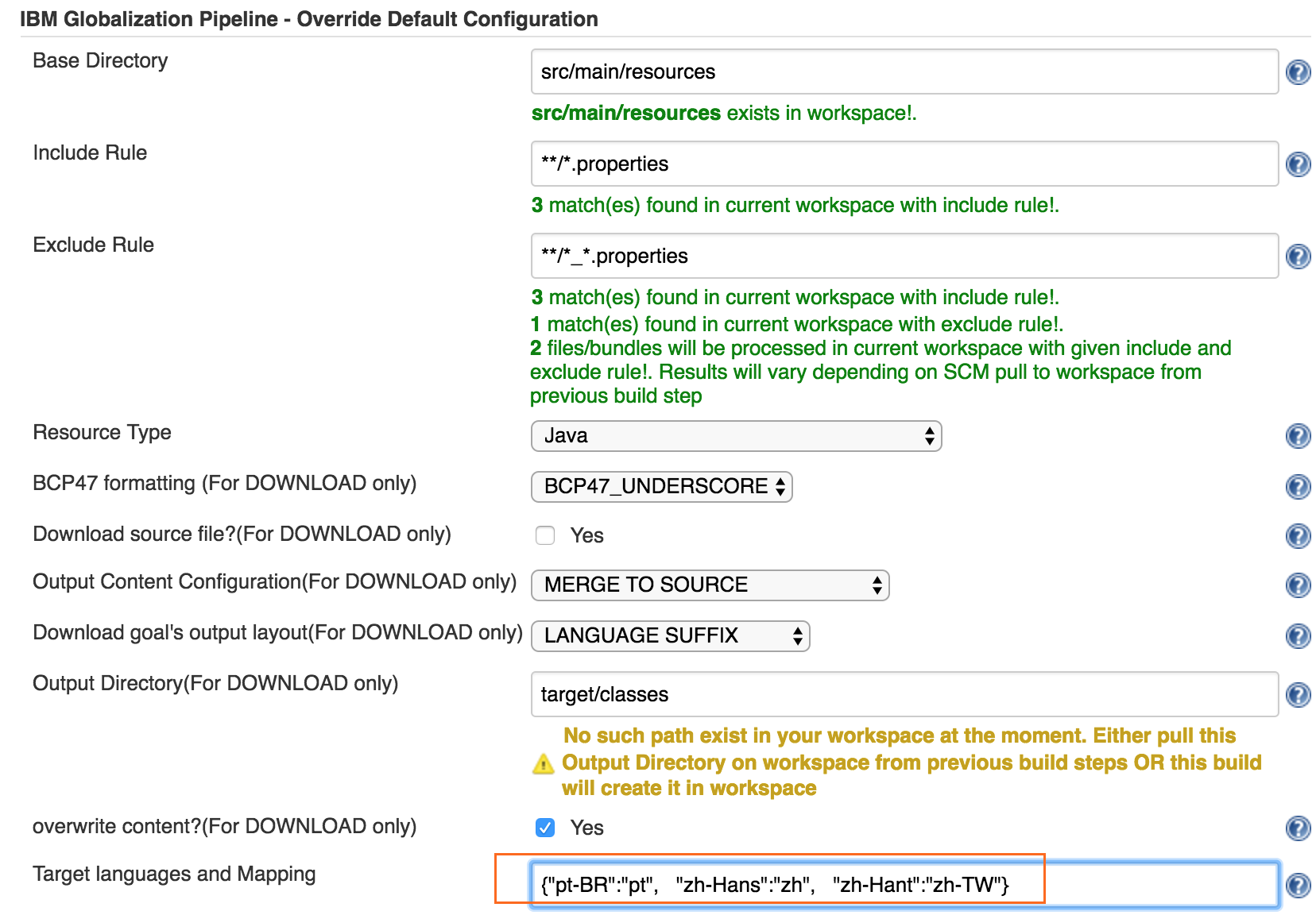
If you have properties file src/main/resources/com/ibm/example/MyStrings.properties,
download goal will generate Brazilian Portuguese translated file target/classes/com/ibm/example/MyStrings_pt.properties
instead of target/classes/com/ibm/example/MyStrings_pt_BR.properties
Note: The language ID separator used in the mapping should be ‘-‘ (Hyphen) for both,
even you want translated file name (or path) to use ‘_’ for the language part. In the example
above, do not specify "zh-Hant" : "zh_TW" even you want MyStrings_zh_TW.properties
as the output file name. The language ID style is configured by BCP47 formatting (For DOWNLOAD only) field.
Translated JSON Files in Language Directories
Your project may need place localized JSON files in its own language directory. Following example supports all JSON files in directory “en” and produces translated versions in parallel language directories.
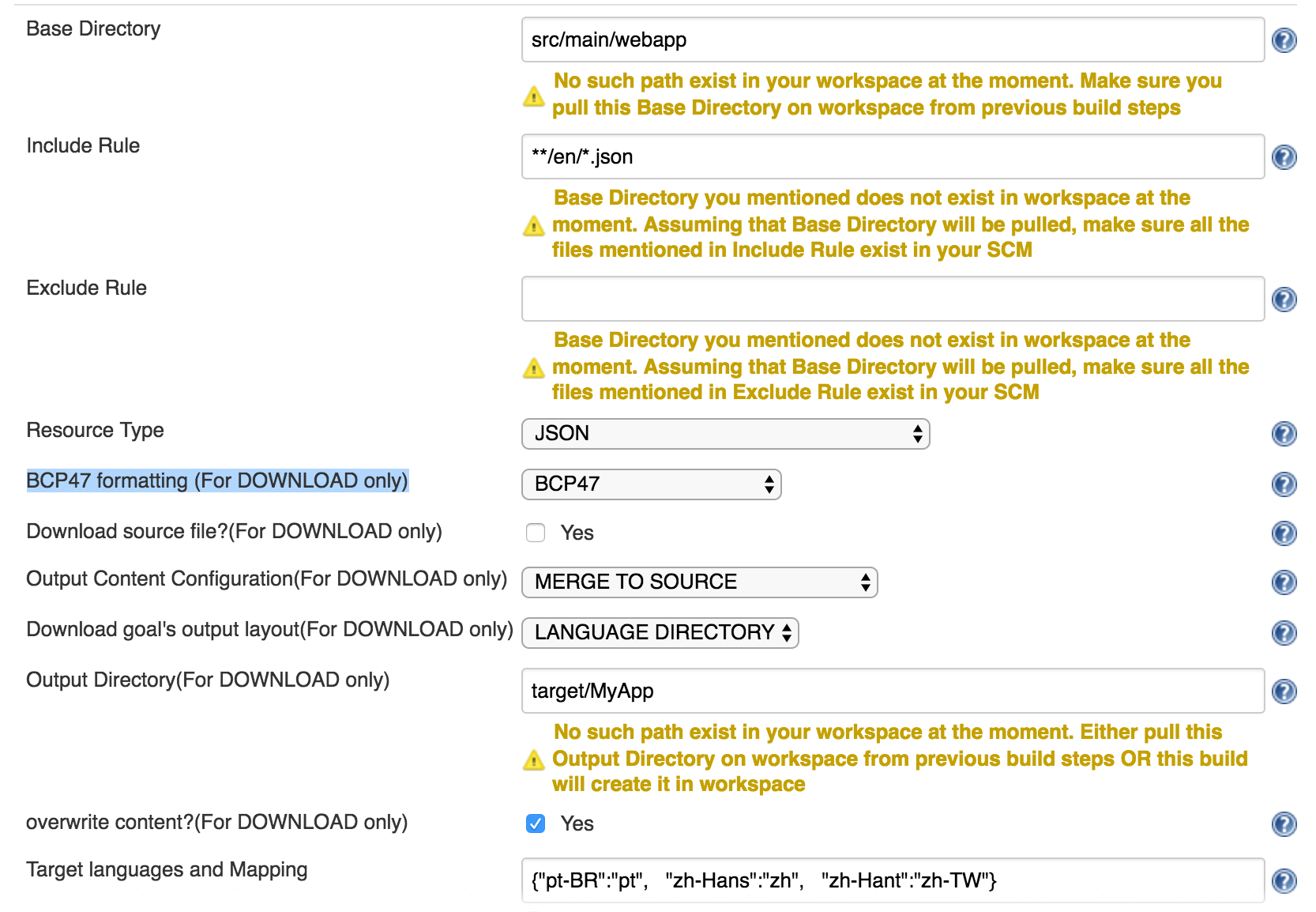
Download goal's output layout(For DOWNLOAD only) field specifies file name/path mapping behavior. LANGUAGE_DIRECTORY specifies
localized version will use the same file name with source, but placed in a directory
for the language. BCP47 formatting (For DOWNLOAD only) field specifies the style of language ID used for
file/path name. BCP47 specifies the BCP 47 language tag. In this case, ‘-‘ (Hyphen)
is used for subtag separators, such as ‘zh-Hans’.
With this example, if you have English JSON resource file at src/main/webapp/res/en/MyStrings.json,
French version is generated at target/MyApp/res/fr/MyStrings.json, and Simplified Chinese
version is generated at target/MyApp/res/zh-Hans/MyStrings.json.
Configuration Parameter Reference
Credentials
Specifies Globalization Pipeline service credentials. There are 4 fields below.
GP URLREST service URL, for example,https://gp-rest.ng.bluemix.net/translate/restUser IDUser IDGP PasswordPasswordInstance IDService instance ID
See Specifying Globalization Pipeline Service Credentials for further information.
Source Language
Specifies BCP 47 language tag for the language used in the source bundles. The default value is “en” (English).
Output Directory(For DOWNLOAD only)
Specifies the output base directory used by download operation.
The default value is the standard Java class file output directory (target/classes).
overwrite content?(For DOWNLOAD only)
Specifies a boolean value to control whether download operation overwrites translated resource bundle files
already in the output directory or not.
The default value “true” (checked)
Base Directory, Include Rule and Exclude Rule
Specifies a set of source bundle files.
Base Directory(required) Base directoryInclude RuleSets for inclusion rules specified by Ant-Style patternExclude RuleSets for exclusion rules specified by Ant-Style pattern
The inclusion/exclusion rules use the standard ant/maven fileset syntax. For example,

Above example includes all the json files under src/MyResources directory, but
excludes all files with file name config.json.
Resource Type
Specifies a resource type. Available options are
- JAVA - Java property resource bundle file
- JAVAUTF8 - Java UTF8 property resource bundle file
- JAVAMSG - Java property resource bundle file with MessageFormat pattern stirngs only
- JAVAMSGUTF8 - Java UTF8 property resource bundle file with MessageFormat pattern strings only
- JSON - Resource string key/value pairs stored in JSON format. For now nested JSON object is not supported.
- AMDJS - RequireJS I18N bundle file
- GLOBALIZEJS - Globalize.js JSON resource bundle file
- IOS - iOS String Resource file
- ANDROID - Android String Resource file
- PO - GNU Gettext portable object file
- POT - GNU Gettext portable object template file
- YML - YAML resource bundle file
- XLIFF - XLIFF 1.2 file
The default value is JAVA.
Target languages and Mapping
This requires a json input.
upload operation is only concerned with key of this json input. Keys specify a list of translation target languages by BCP 47 language tags
For example,
{"fr" : "Not concerned with upload", "zh-Hans" : "Anything for upload"}
with upload operation creates a new Globalization Pipeline bundle with French and Simplified Chinese translation languages.
download operation takes both keys and mapped values of this json input into consideration.
This specifies custom language mappings. Each key is a BCP 47 language tag
used by Globalization Pipeline service instance, and the element value is a language ID used for
output resource file or path name. For example, Globalization Pipeline service uses language ID
“pt-BR” for Brazilian Portuguese. If you want to use just “pt” for output file or path name, you
can specify the mapping as below.
{"pt-BR" : "pt"}
By default, All BCP47 language tags i.e target languages served by Globalization Pipeline are kept as key and same is kept for values.
BCP47 formatting (For DOWNLOAD only)
Specifies one of following options to configure the rule for composing language ID used for output resource bundle file or path name.
- *BCP47_UNDERSCORE** BCP 47 language tag, replacing ‘-‘ with ‘_’. For example, *zh_Hant for Traditional Chinese.
- BCP47 BCP 47 language tag itself. For example, zh-Hant for Traditional Chinese
The default value is BCP47_UNDERSCORE.
Output Directory(For DOWNLOAD only)
Specifies the output base directory for the sets of bundles chosen by above options.
Download source file?(For DOWNLOAD only)
Specifies a boolean value to control whether download goal also produces resource bundle
files for a source language.
The default value is “false”. (Unchecked)
Output Content Configuration(For DOWNLOAD only)
Specifies one of following options to control how download goal generates the contents of
translated resource bundle files.
- MERGE_TO_SOURCE Duplicates the contents of the source bundle and replaces only translated resource strings. This option might not be implemented by some format types. In this case, TRANSLATED_WITH_FALLBACK is used instead.
- TRANSLATED_WITH_FALLBACK Emits only resource strings (with a simple header if applicable). When translated string value is not available, the value in the source language is used.
- TRANSLATED_ONLY Emits only resource strings (with a simple header if applicable). When translated string value is not available, do not include the key in the output.
- MERGE_REVIEWED_TO_SOURCE Duplicate the contents of the source bundle and replaces only translated resource strings marked as reviewed. This option might not be implemented by some format types. In this case, REVIEWED_WITH_FALLBACK is used instead.
- REVIEWED_WITH_FALLBACK Emits only resource strings marked as reviewed. When translated string value is not available, or not marked as reviewed, the value in the source language is used.
- REVIEWED_ONLY Emits only resource strings marked as reviewed. When translated string value is not available, or translated not marked as reviewed, do not include the key in the output.
The default value is MERGE_TO_SOURCE.
Download goal's output layout(For DOWNLOAD only)
Specifies one of following keywords to control output file name or path in download goal.
- LANGUAGE_SUFFIX In the same directory with the source bundle file, with extra language suffix.
For example, if the source bundle file is
com/ibm/g11n/MyMessages.properties, then the French version will becom/ibm/g11n/MyMessages_fr.properties. - LANGUAGE_ONLY In the same directory with the source bundle file, using language code as the file name with the original file extension. For example, if the source bundle file is
res/en.json, then the French version will beres/fr.json. - LANGUAGE_SUBDIR In a language sub-directory under the directory where the source bundle file
is placed. For example, if the source bundle file is
res/MyMessages.json, then the French version will beres/fr/MyMessages.json. - LANGUAGE_DIR In a language directory at the same level with the source bundle file.
For example, if the source bundle file is
com/ibm/g11n/en/MyMessages.properties, then the French version will becom/ibm/g11n/fr/MyMessages.properties.
The default value is LANGUAGE_SUFFIX.
Custom Resource Filter (Optional)
Globalization Pipeline Resource Filter provides a mechanism to implement your own custom filter, that can be used through Globalization Pipeline Maven Plugin/Ant Task and other tools (including this Jenkins Plugin).
To embed your own custom filter with this Jenkins plugin, follow these steps (showing an example of CSV filter)
- Add your custom resource filter dependency in pom.xml

The image above uses the example of csv-res-filter. Please use it for reference to create your own custom filter.
-
Add your filter type in config.jelly
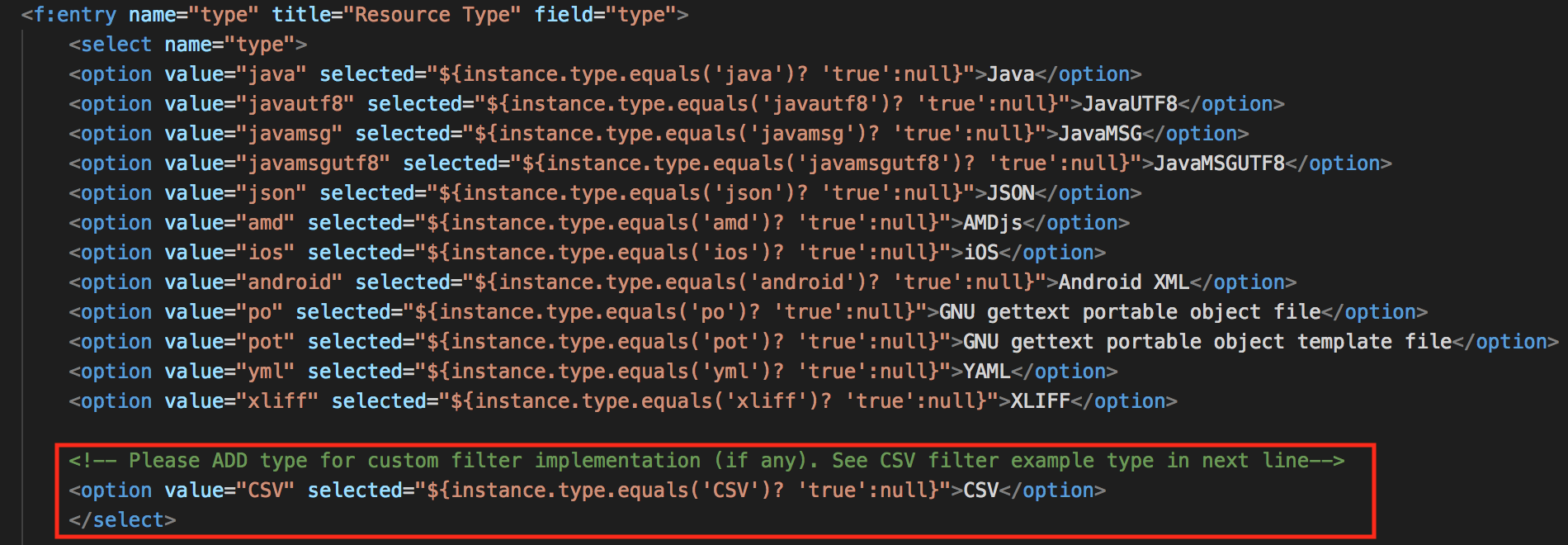
-
Allow Jenkins to load your provider class in GlobalizationPipelineBuilder.java This is right above the
uploadpart of implementation